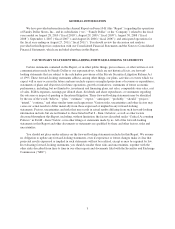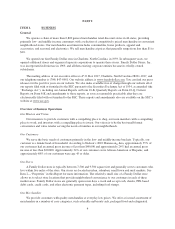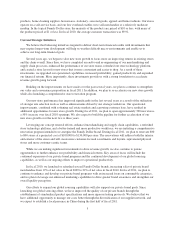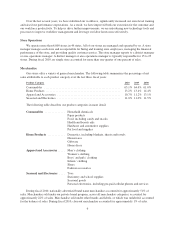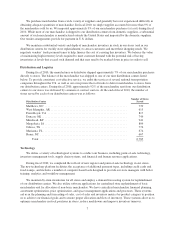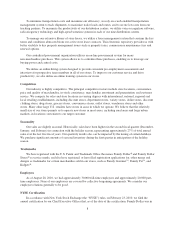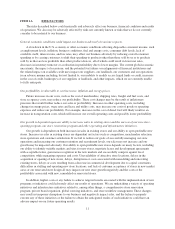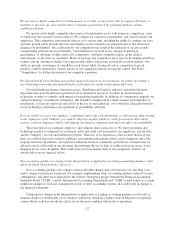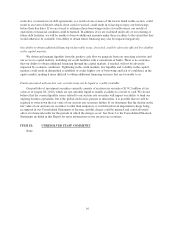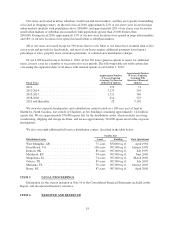Family Dollar 2010 Annual Report Download - page 17
Download and view the complete annual report
Please find page 17 of the 2010 Family Dollar annual report below. You can navigate through the pages in the report by either clicking on the pages listed below, or by using the keyword search tool below to find specific information within the annual report.Changes in state or federal legislation or regulations, including the effects of legislation and regulations on
wage levels, employee rights, health care, social welfare and entitlement programs could increase our cost of
doing business.
We are exposed to the risk that federal or state legislation, particularly related to our team members, may
negatively impact our operations. Changes in federal or state wage requirements, employee rights (including
changes in the process for our employees to join a union), health care, social welfare or entitlement programs
such as health insurance, paid leave programs, or other changes in workplace regulation or tax rates could
adversely impact our ability to achieve our financial targets.
In 2010, Congress enacted comprehensive health care reform legislation which, among other things,
includes guaranteed coverage requirements, eliminates pre-existing condition exclusions and annual and lifetime
maximum limits, restricts the extent to which policies can be rescinded, and imposes new and significant taxes
on health insurers and health care benefits. Due to the breadth and complexity of the health reform legislation,
the current lack of implementing regulations and interpretive guidance, and the phased-in nature of the
implementation, it is difficult to predict the overall impact of the health reform legislation on our business over
the coming years. Possible adverse effects of the health reform legislation include increased costs, exposure to
expanded liability and requirements for us to revise ways in which we conduct business.
Product safety concerns and the effects of legislation and regulations on product safety and quality could affect
our sales and results of operations adversely.
We are exposed to the risk that federal or state legislation and regulations regarding product quality and
safety may negatively impact our operations. Any changes in product safety or quality legislation or regulations
may lead to product recalls and the disposal or write-off of merchandise inventories, as well as certain fines or
penalties and reputational damage. Our inability to comply on a timely basis with regulatory requirements, or to
execute product recalls in a timely manner, could also result in substantial fines or penalties, which could have an
adverse effect on our financial results. In addition, negative customer perceptions regarding the safety of the
products we sell could cause us to lose market share to our competitors. If this occurs, it may be difficult for us to
regain lost sales.
Any disruption in our ability to select, obtain and market merchandise attractive to customers at prices that
allow us to profitably sell such merchandise could impact our business negatively.
We generally have been able to select and obtain sufficient quantities of attractive merchandise at prices that
allow us to profitably sell such merchandise. If we are unable to continue to select products that are attractive to
our customers, to obtain such products at costs that allow us to sell such products at a profit, or to market such
products effectively to consumers, our sales or profitability could be affected adversely. In addition, the success
of our business depends in part on our ability to identify and respond promptly to evolving trends in
demographics and consumer preferences, expectations and needs. Failure to maintain attractive stores and to
timely identify or effectively respond to changing consumer needs, preferences and spending patterns could
adversely affect our relationship with customers, the demand for our products and our market share.
Any disruption in the supply or increase in pricing of our merchandise could negatively impact our ability to
achieve anticipated operating results. A significant amount of our merchandise is manufactured outside the
United States, and changes in the prices and flow of these goods for any reason could have an adverse impact on
our operations. For example, because a substantial amount of our merchandise is manufactured in China, a
change in the Chinese currency or other policies could negatively impact our merchandise costs. The United
States and other countries have occasionally proposed and enacted protectionist trade legislation, which may
result in changes in tariff structures and trade policies and restrictions that could increase the cost of or reduce the
availability of certain merchandise. Any of these or other measures or events relating to suppliers and the
13


